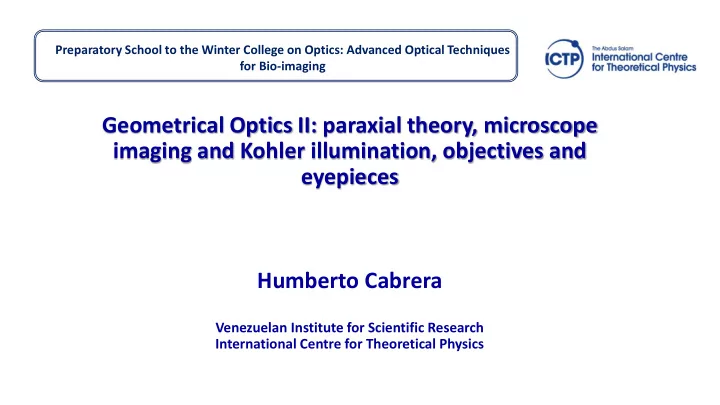

Preparatory School to the Winter College on Optics: Advanced Optical Techniques for Bio-imaging Geometrical Optics II: paraxial theory, microscope imaging and Kohler illumination, objectives and eyepieces Humberto Cabrera Venezuelan Institute for Scientific Research International Centre for Theoretical Physics
Imaging
Imaging
Finite objetive lens
Infinite objetives work with tube lens to produce an image
Projecting the image to your eyes
Imaging with a camera at the intermediate imaging plane
Imaging with a camera at the eyepiece imaging plane
Illuminating the specimen
Kohler illumination
Critical illumination
Kohler illumination versus critical illumination why kohler illumination? Ligh Light sou ource im image pla lanes: • La Lamp fila filament • Con Condenser dia iaphragm • Ba Back foc ocal l pla lane e of of th the e ob obje jectiv ive • The e eyep epoint Spec ecimen im image pla lanes: • Field ield dia iaphragm • Spec ecimen • In Intermedia iate im image pla lane (th (the e eyep epie iece dia iaphragm) • The e eye e reti tina or or camera sen ensor
Conjugates planes In Infin init ite ob objetive Fin init ite ob objetive Conjugate planes are simultaneously in focus and appear superimposed when viewing through the microscope
Objective lenses and optical aberrations Ther ere ar are e man any clas classes of of ob objectiv ive le lense ses Common ob objectiv ive op optical correction factors Aberration correction Tran ansmis ission Resolvin ing power
Aberration correction • Achromats • Axial - red and blue (656 nm-486 nm) • Spherical - Green - 546 nm • Fluorites (Semi-Apo) • Axia ial l -2 2 to o 4 4 col olors • Sp Spherical - 2 2 to 4 4 colors • Apochromats • Axia ial l - 4 4 to 5 5 colors - vio viole let, blu lue, green an and red All available in “Plan” versions
Numerical aperture NA= n.sin ( α ) α : : the the ha half lf op openin ing an angl gle of of the the ob objectiv ive or or an angl gle of of the the con one of of ill illum umin ination n: n: the the ref refractiv ive in inde dex of of the the im immers rsion mediu edium us used be between the the ob objectiv ive an and d the the ob object • Air ir n=1 =1.0 • Water n=1. 1.33 • Oil il an and glas lass n=1 =1.5
Numerical aperture
Why immersion media increases NA? Maximum NA=1.49 in oil and NA=1.27 in water
How immersion medium affects the true N.A. and consequently resolution No immersion (dry) • Max. Value for a = 90 ° (sin = 1) Beampath • Attainable: sin a = 0.95 ( a = 72 ° ) No oil Oil Snell ’ s Law: • Actual angle a 1 : n 1 sin b 1 = n 2 sin b 2 a 1 a 2 NA 0 . 95 a o arcsine arcsine 39 1 1 . 52 n 1 With immersion oil (3) 3 n=1.518 • a 1 a 2 No Total Reflection 2 • Objective aperture fully usable 1) Objective • N.A. max = 1.45 > Actual angle a 2 : 2) Cover Slip, on slide 3) Immersion Oil 1 . 45 NA a o arcsine arcsine 73 2 n 1 . 518
Chromatic aberrations
Chromatic aberrations correction
Chromatic aberrations correction
Spherical aberrations
Spherical aberrations correction
Objective Magnification Mag agnification of of th the Mic icroscope • M Micr icroscope = = M Objective X X M M Eyepiece X X M In Intermediate Factor M = = Mag agnification Example le: Objective = = 60 60 x Eyepiece = = 10 10 x Intermedia In iate Factor = = 1 1 x Overall ll M = = 600 600 x
Features of an objective
Thanks
Recommend
More recommend